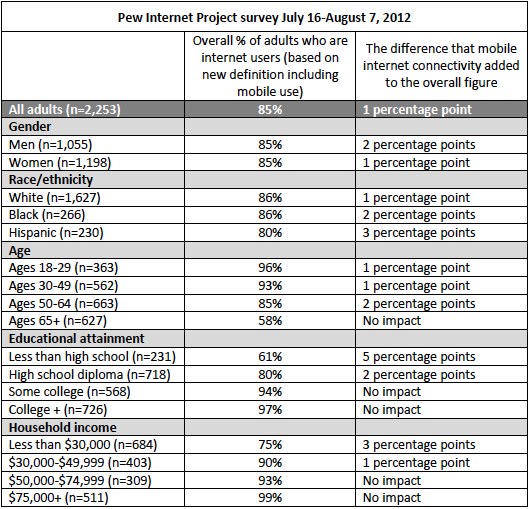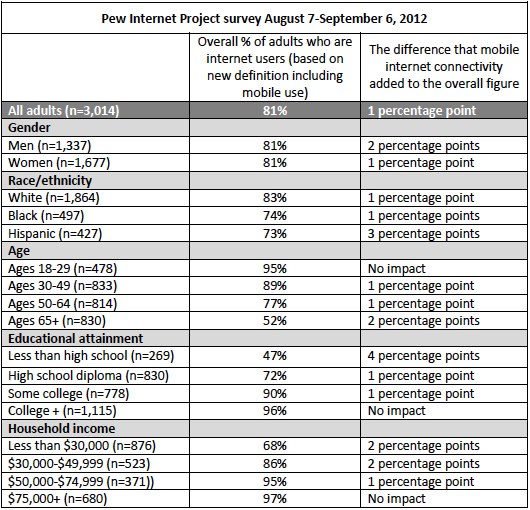In our surveys this summer, we added a question about mobile internet connectivity to help us capture internet users who may access the internet on mobile devices.
The Pew Internet and American Life Project has been gathering national-level data on Americans’ internet use for more than 12 years. As the nature of internet use has changed over time, we have adapted our question wording to reflect new behaviors. In our surveys this summer, we added a question about mobile internet connectivity to help us capture internet users who may access the internet on mobile devices. When we include people who say they access the internet on mobile devices, this adds approximately one percentage point to the overall number of adult internet users1 in America. This increase is within the margin of error for the overall population. When we look at the size of the internet-user population in several demographic groups, the increases are greater than the one percentage point increase we see in the general adult population. However, these results have not been uniform and these demographic subgroups have larger margins of error than the population as a whole.
Here’s the background: For several years, we have calculated the number of internet users in our surveys by asking two questions:
1. Do you use the internet, at least occasionally?
2. Do you send or receive email, at least occasionally?
We counted internet users as anyone who said “yes” to either question. Of course, the vast majority of internet users said “yes” to both questions. But we had learned over the years that some email users did not necessarily count themselves as internet users. As a rule, but not always in our surveys, older users were more likely to say “yes” to the email use question and “no” to the internet-use question. Overall, adding the “yes” respondents to the email question to our calculation added between one and three points to the overall internet user total.
Starting in our August 2012 Tracking Survey, we added a third question to our internet-user screening questions:
3. Do you access the internet on a cell phone, tablet or other mobile handheld device, at least occasionally?
Now, we count internet users as anyone who says “yes” to any of those three questions. We have conducted two surveys using this new question language (one in August 2012 and a second in September 2012), and an analysis of each follows.
In our survey in August of 2,253 adults, 85% were considered internet users by this definition. The “yes” responses broke down this way:
- 83% of adults said “yes” to the first question – that they “use the internet, at least occasionally.”
- 76% said “yes” to the email question – that they “send or receive email, at least occasionally.”
- 58% said “yes” to the mobile question – that they “access the internet on a cell phone, tablet, or other mobile handheld device, at least occasionally.
The “yes” respondents to the mobile question added one percentage point to the overall tally of internet users. In other words, 1% of our sample said they connected to the internet with a mobile device, but answered “no” to the first two questions.
In September, our survey of 3,014 adults showed that 81% of them were considered internet users by these criteria and the “yes” respondents to the mobile question added one percentage point to the overall internet-user population size. The “yes” answers in this survey broke down as follows:
- 78% of adults said “yes” to the first question – that they “use the internet, at least occasionally.”
- 72% said “yes” to the email question – that they “send or receive email, at least occasionally.”
- 55% said “yes” to the mobile question – that they “access the internet on a cell phone, tablet, or other mobile handheld device, at least occasionally.
So why, you may ask, are surveys in August and September getting different internet-user numbers? As you can see from our chart showing internet use over time, the general trend line points in a clear direction but these figures fluctuate a bit from survey to survey.
Demographic differences when mobile connectivity is added
It turns out that in each of the new surveys, there was a slightly different impact of incorporating the mobile question into the internet-use figure for different groups. Adding a mobile component to our internet user definition seems to have an outsized impact on our internet usage estimates among those adults who have not graduated from high school. Using our August data, adding the mobile question increases our estimates for internet use among this group by five percentage points, and using our September data it increases our estimate for this group by four percentage points.
However, it is important to note that this group is a relatively small one–with a margin of sampling error of approximately +/-7 percentage points–and the fact that we need to track this question over a number of surveys before we feel comfortable drawing any firm conclusions from these results.
The following table shows the impact of our new question wording for our August 2012 survey:

And this table shows the impact of our new wording for our September 2012 survey.

The total picture of internet users and their connectivity
This new question on mobile connectivity gives us a richer picture of how people connect in multiple ways to the internet. For instance, our August 2012 figures can be broken down this way:
- 85% of adults connect to the internet in one way or another
- 53% of adults answer “yes” to all three of our screening questions – they use the internet, they have email, and they connect with a mobile device.
- 22% of adults answer “yes” to questions 1 and 2 – they generally connect to the internet, they use email, but they don’t connect with a mobile device.
- 4% of adults answer “yes” to questions 1 and 3 – they generally connect to the internet, they connect by mobile device, but they don’t use email.
- 4% answer “yes” to question 1 alone – they generally connect to the internet, but they don’t use email and they don’t connect via mobile device.
- 1% of adults answer “yes” to question 3 alone – they connect via mobile device, but they answer “no” to questions 1 and 2.
- 1% of adults answer “yes” to question 2 alone – they use email, but they answer “no” to questions 1 and 3.
And, of course, 15% of adults answer “no” to all three questions. They don’t connect to the internet in any fashion.




